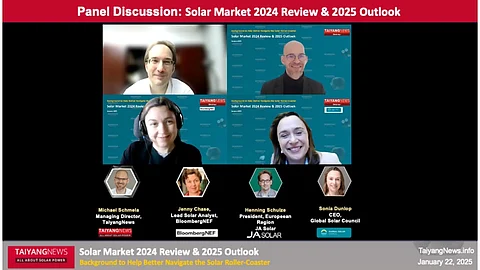

BloombergNEF’s Jenny Chase, JA Solar’s Henning Schulze, and GSC’s Sonia Dunlop discussed their perspectives on the global solar market during the recent TaiyangNews webinar on Solar Market 2024 Review & Outlook 2025
The year 2024 was brought the focus on patents and increased competition which is likely to lead to a more structured industry
Need of the hour is for the global PV industry to unite and speak in one voice with regulators and policymakers to ensure sustainable and solid growth in the future
Driven by technological advancements and significant cost reduction efforts, the solar PV market grew exponentially in 2024, reaching 599 GW DC in annual installations, despite overcapacity concerns and power prices coming down in Europe. The question is can it keep up the momentum in 2025 as well?
To discuss this question, TaiyangNews Managing Director Michael Schmela recently engaged in an insightful discussion with leading industry stakeholders, Bloomberg New Energy Finance’s (BloombergNEF) Lead Solar Analyst Jenny Chase, JA Solar’s European Region President Henning Schulze, and Global Solar Council CEO Sonia Dunlop.
The occasion was the TaiyangNews Webinar on Solar Market 2024 Review & Outlook 2025 on January 22, 2025.
When asked by Schmela to rate the year 2024 on a scale of 10 for the global PV industry, Jenny Chase gave it a full 10, saying that she believed it was a good year as a lot of solar was deployed from the perspective of energy transition. It contributed toward reducing fossil fuel burn, particularly in Europe and Pakistan, among other places.
On the other hand, Henning Schulze scored it a 6 from an industry perspective, citing very fierce competition and the focus it brought on the patent debate. This was a defining year, according to him, since the overcapacity resulted in a margin squeeze for the companies. He stressed that this will be a good thing in the long run as it will lead to a more structured industry since some players may be forced out of the market, which is also ‘very important.’
For Sonia Dunlop, the year 2024 was a 7 on the scale characterized by high year-on-year growth, but the challenges in terms of policy and geopolitics continue to remain tough. Solid growth requires a strong narrative going forward which, she said, needs a lot more work.
The speakers also reflected on the positives and negatives for 2024, with Chase listing South Africa as a surprise element in 2024. This PV market slowed down in terms of installations last year as there were fewer blackouts compared to 2023, which was a boom year. This, she explained, shows the impact of market conditions on solar.
For Schulze, it was positive that the European Union (EU) did not go for trade measures against Chinese cells and modules as a strategic measure for the industry’s growth. On the other hand, for Dunlop, Brazil imposing 25% tariffs on imported solar modules was a negative surprise that she attributed to political forces conspiring to lead to that. The positive, she quipped, was to see big investors from all over the globe, from London and New York to Tokyo starting to shift to PV.
Going forward, the trio agreed that even though the industry forecasts are conservative as of now (as they see the market not growing exponentially till 2030), there may be individual market surprises like Pakistan last year that may tilt the annual installation forecasts higher.
Storage could also be a game changer for solar installations as the market really needs flexibility, according to Dunlop, but it would need a regulatory framework in more and more markets like the US, which is hard to come by so soon. She also called rooftop solar a vote winner as it can help households reduce their electricity bills. This immense political power of rooftop solar is something that governments need to get behind.
From a policy perspective, Dunlop said that even as the solar industry grows, the challenges are getting more complex with regard to market design, regulatory concerns, flexibility, reform of electricity markets, batteries, and storage, among others. The need of the hour, she believes, is for the industry to organize and speak in one voice at regional, national and global levels.
Dunlop signed off saying, “We need to get better at getting our needs and views and interests across to the regulators, to policymakers in order to solve these challenges. We really need to be investing in our industry associations all over the world to make sure that we don't run into trouble in markets in the future like we've done a couple of times in the past.”
The complete panel discussion and video recordings of the presentations during the webinar are available on the TaiyangNews YouTube channel. These can be accessed here. A conference summary of the webinar is also online (see BloombergNEF Forecasts 670 GW DC New Global Solar PV Installations In 2025 During TaiyangNews Event).
